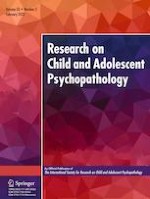07-01-2021
Development and Validation of the Parental Assistance with Child Emotion Regulation (PACER) Questionnaire
Gepubliceerd in: Research on Child and Adolescent Psychopathology | Uitgave 2/2022
Log in om toegang te krijgenAbstract
Caregivers play a central role in promoting emotion regulation throughout infancy, childhood, and adolescence. However, there are no existing psychometric measures to assess how parents assist children in employing emotion regulation strategies for negative emotions. We therefore developed the Parental Assistance with Child Emotion Regulation (PACER) Questionnaire to assess the degree to which parents assist their children in their use of ten different regulation strategies. In this paper, we describe the development of the PACER and examine its psychometric properties (N = 407 parents of children ages birth to 17 years). In so doing, we also use the PACER to comprehensively explore the links between parent-assisted emotion regulation and indices of parent and child stress, symptomatology, and attachment. Confirmatory factor analyses of the PACER items supported its intended ten-factor structure (corresponding to ten specific regulation strategies), which was invariant across different child age and sex categories. PACER scale scores had excellent internal consistency and generally acceptable test–retest reliability over a one-week period. Convergent validity was established via correlations between PACER scales and indices of parental emotion sensitivity, expressivity, and regulation, as well as parents’ perception of the efficacy of their assistance with children’s execution of emotion regulatory strategies. Lower parental facilitation of stereotypically adaptive emotion regulatory strategies was associated with higher child internalizing and externalizing problems and with poorer parent–child relationship quality. Overall, these findings suggest that the PACER may be a useful tool for the assessment of parental assistance with child emotion regulation across development.
